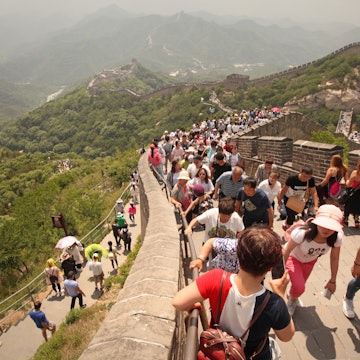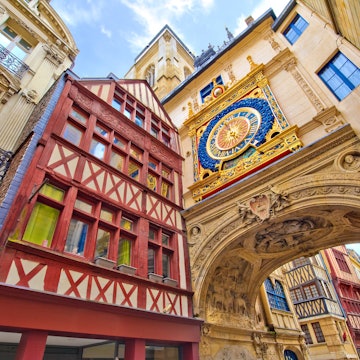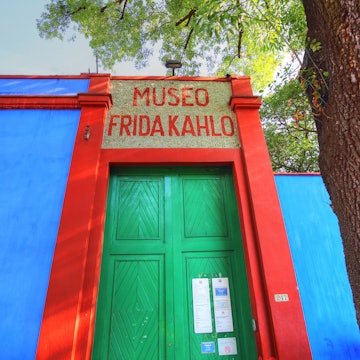

There is a partial reopening at Reina Sofía Museum in Madrid © Denis Doyle / Getty Images
With footfalls that outdo the great wildebeest migration kicking up dust across the Serengeti, it’s rare to visit the world’s busiest museums and have, say, the sunny Californian solitude of Hockney’s A Bigger Splash to yourself, or a one-to-one staring contest with the green-patinated Head of Augustus. So as the dust sheets are lifted at some of the most popular museums on the planet, what can travelers expect with COVID-19 restrictions in place? We masked up for a whistle stop tour to find out.

Have longer with the Mona Lisa at the Louvre, Paris
If there’s one person who’s been content with having four months off, it’s Mona Lisa. Hung inside an anti-reflective protective glass box at the Louvre’s recently renovated Salle des États, Leonardo da Vinci’s golden girl was furloughed from her role as the world’s most gawked-at woman on March 13.
In the sticky pre-pandemic heat of a Parisian summer, some 36,000 people would shuffle in a line each day to catch the oil-paint gaze of Lisa del Giocondo. But one-on-one, da Vinci’s depiction didn’t discriminate between art historians, selfie snappers, or bucket-list-ticking dilettantes. By the gallery’s own count, each ticket-holder only got 50 seconds with the painting before being moved on, their necks craned backwards.
Flip the calendar to July 6 and the busiest museum in the business unbolts its doors once more. But with social-distancing de rigueur in France and masks absolutely mandatory for those aged 11 and above, a visit to the Louvre in 2020 is going to be a different experience.
The bad news? Waiting lines for the Mona Lisa will be doubled. The good? Visitors will get unlimited time to enjoy the painting. Visitor numbers of 5000–10,000 are expected each day, most of whom will be domestic.

Tate Modern brings in timed entries, London
Whether it’s colorful compositions like the torn paper of The Snail by Henri Matisse or the oceanic anguish burrowed within David Oxtoby’s Mingus Deep Blues, the wealth of contemporary artwork at London’s Tate Modern makes other galleries look as if they haven’t got a Duchamp’s Fountain to pee in.
Reopening on July 27, along with its three sister galleries, the Tate Modern has introduced a timed ticketing system, and bookings must be made in advance online. One-way systems have been put in place and visitors have been warned to “prepare for a bit more walking than usual.”
“Some of our most popular current exhibitions – like Kara Walker’s Fons Americanus at Tate Modern and Steve McQueen’s Year 3 at Tate Britain – are located in very large spaces with plenty of room for social distancing,” explains Ellen Weerasekera from the Tate, “especially with the staggered entry times and pre-booked ticketing systems that will be in place when we reopen.”

Keep your distance at the Sistine Chapel, Rome
The centerpiece of Michelangelo's delicate Sistine Chapel fresco animates the biblical story of God giving life to Adam – their pale arms are outstretched, their fingers almost touching. But under the new rules of Rome’s Vatican Museums, the Guard Corps would ask the pair to leave for not maintaining a distance of over 1 meter, a rule that the museum says must be “respected scrupulously”.
Pre-pandemic, more than 2000 visitors could congregate in the Sistine Chapel at once, but numbers have now been limited. To combat that, opening hours have been extended through the week to allow more people to enjoy the museums and gardens, but booking is now compulsory.
Each ticket holder is to be given a strict 15-minute time slot and must pass a temperature check before entry. Face masks are also compulsory throughout. Tours have now restarted, but only for groups of up to 15 people. The Excavations of St John Lateran tour remains off-limits.
Get close to Guernica at Centro de Arte Reina Sofía, Madrid
Madrid’s Centro de Arte Reina Sofía, home to Pablo Picasso’s stirring achromatic masterpiece Guernica, has partially reopened, capping total visitor numbers to around one-third of its usual capacity, with strict policies on how many ticket-holders can enter each room.
Providing a principal romp through the great Spanish art of the 20th century, its collection also includes the shape-shifting endeavours of Salvador Dalí and the shattered-glass cubist stylings of Juan Gris. A timed-entry system is now in place along with one-way routes throughout the museum.
The upside is that each traveler should get more time with the art itself and, in an effort to minimise the spread of COVID-19, all the museum’s booklets are available to download digitally. Masks are also mandatory.

Health checks at the National Museum of China, Beijing
As the largest single-building museum on Earth, the colossal National Museum of China holds a collection weaving through more than 5000 years of Chinese culture, from the neolithic jade dragon of Hongshan to a delightful Tang dynasty-era model of a camel carrying musicians in colorful glazed earthenware.
Shut for exactly 100 days due to COVID-19, the Beijing institution reopened on May 1 with a number of restrictions. Visitor numbers are currently capped at 3000 per day (a reduction of 90%) and body temperature checks are mandatory on entry.
As with other institutions in China, ticket-holders will need to scan a QR code on an app to confirm their health status before they are granted entry. The app, which has personal information such as your name, passport number, travel history and contact details on it, will go green if you’re allowed to enter. Amber will mean quarantining for seven days, red requires you to self-isolate for 14 days.
You might also like:
The art of escaping the holiday crowds in the UK
Some countries want us to visit - but are we ready to travel?
How to prepare for your first post-COVID trip
















